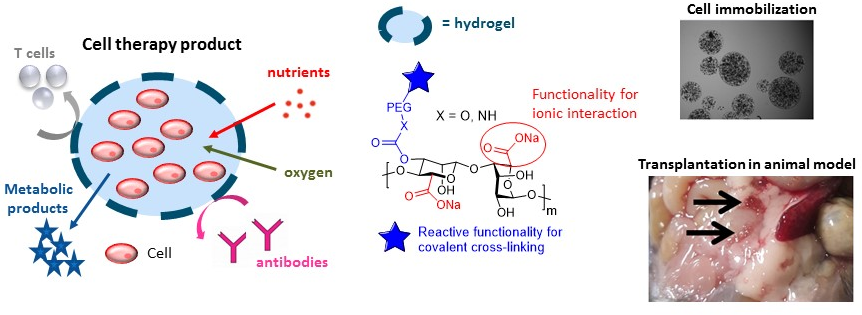Functionalization of Sodium Alginate Hydrogels for Cell Microencapsulation
Cell based therapies, especially transplantation of microencapsulated cells, open doors for new medical and clinical modalities, and offer an alternative solution to whole organ transplantation for the treatment of various diseases, such as type 1 Diabetes Mellitus or acute liver failure. The success of the cell transplantation highly depends on the quality of both the encapsulating biomaterial and the source of cells.
Encapsulation materials should fulfill many requirements, including biocompatibility, adjustable physical characteristics, and the microencapsulation process must be simple and not harm the cells.1 While sodium alginate (Na-alg) benefit from the spontaneous formation of hydrogels in the presence of divalent cations (Ca2+, Ba2+) and present high biocompatibility, its mechanical and permselectivity properties are not optimal. To improve the properties of hydrogels formed from Na-alg, our group has developed a variety of hybrid hydrogels combining the alginate backbone with poly(ethylene glycol) derivatives.2─7 The simultaneous presence of the electrostatic ionic crosslinking of alginate with divalent cations (such as Ca2+) provides fast gelation and spherical beads, while the chemical crosslinking through covalent linkages of the PEG chains is responsible for the reinforcement of the hydrogel.
We herein present the synthesis of heterobifunctional PEG derivatives, their conjugation to the alginate backbone through a variety of covalent linkages and the preparation of hybrid microspheres. Physical characterization of the formed beads as well as in vivo and in vitro evaluation of their potential for cell immobilization and transplantation will be discussed.

[1] Redouan Mahou et al. Xenotransplantation, 2016, 23, 179-201.
[2] Redouan Mahou et al. Macromolecules, 2010, 43, 1371-1378.
[3] Redouan Mahou, Hybrid microspheres for cell encapsulation, 2011, 5163.
[4] Redouan Mahou et al. Chem. Mater. 2015, 27, 4380-4389.
[5] Redouan Mahou et al. J Mater Sci: Mater Med, 2012, 23, 171-179.
[6] Redouan Mahou et al. Macromol. Symp., 2013, 329, 49-57.
[7] Gerber S. et al. Patent application, 2016, EP16188771